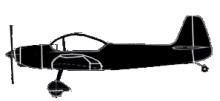
ASN Wikibase Occurrence # 144415
This information is added by users of ASN. Neither ASN nor the Flight Safety Foundation are responsible for the completeness or correctness of this information.
If you feel this information is incomplete or incorrect, you can submit corrected information.
| Date: | Thursday 15 March 2012 |
| Time: | 12:55 |
| Type: |  Piel CP-301A Emeraude |
| Owner/operator: | Private |
| Registration: | N718PP |
| MSN: | 313 |
| Total airframe hrs: | 850 hours |
| Engine model: | Continental 0-200 SERIES |
| Fatalities: | Fatalities: 2 / Occupants: 2 |
| Aircraft damage: | Substantial |
| Category: | Accident |
| Location: | About a mile northeast of Ruckel Airport - FL17, Niceville, FL -
 United States of America United States of America
|
| Phase: | En route |
| Nature: | Private |
| Departure airport: | Niceville, FL (FL17) |
| Holt, FL (FD93) | |
| Investigating agency: | NTSB |
| Confidence Rating: |
The pilot/owner had been in a previous airplane accident which resulted in traumatic brain injuries. Subsequent to that accident, he acquired an experimental amateur-built airplane, which he would only taxi because of his lack of medical clearance. Anticipating a return to medical status, the pilot asked another pilot to serve as pilot in command and fly with him to another airport for the airplane’s condition inspection.There were no witnesses to the engine start, taxi time, or takeoff to the north. An air traffic controller at a nearby air force base was contacted by one of the pilots, who reported that the airplane just departed the airport, as was the custom. The controller then attempted to contact the airplane twice to determine the pilots’ intentions but received no response. Radar data indicated a brief, primary (skin paint) return at the time, but no track or altitude could be determined. During the initial climb, a witness saw the airplane when it was about halfway down, and about 300 to 400 feet above the runway, and heard a power reduction. The airplane did not turn to return to the runway, but continued straight ahead over trees, and the witness eventually lost the sound of the engine. A motorist subsequently saw the airplane, gliding south, back toward the departure airport with the propeller stopped, before he lost sight of it behind trees. The airplane later impacted trees, wings level, heading eastbound, just north of a new highway.
Because both pilots were ejected from the airplane, it was not possible to determine which pilot had been in which seat or who was flying. The engine had also separated from the main wreckage, which likely altered the positions of the engine controls, including the carburetor heat. Torsional bending of one of the propeller blades, as well as malleable bending (heating) of the exhaust system indicated that the engine was under some power at impact; an examination of the engine did not reveal any malfunctions or failures that would have precluded normal operation. Dark spark plug electrodes were noted and are consistent with a very rich mixture, either from carburetor icing or carburetor heat, or both. Weather data recorded near the time of the accident indicated an outside air temperature of 82 degrees F and a dew point of 64 degrees. Carburetor icing probability charts indicated the likelihood of serious carburetor icing at glide power for the temperature and dew point conditions. Because one of the pilots made a normal departure call, the effects of carburetor ice were probably first noticed subsequent to that call. At some point, the engine lost power and the pilots attempted to turn back toward the airport. They were then likely able to at least regain at least some power, likely by applying carburetor heat, but were too low to recover.
Probable Cause: The pilots’ inadequate use of carburetor heat, which resulted in carburetor icing and a subsequent loss of engine power.
Accident investigation:
 |
|
Sources:
NTSB
Location
Images:

A photo of the accident aircraft from May 2010 at the 1st Annual Brewton Fly-in in Brewton, AL.
Revision history:
| Date/time | Contributor | Updates |
|---|---|---|
| 15-Mar-2012 14:09 | gerard57 | Added |
| 15-Mar-2012 14:55 | harro | Updated [Time, Aircraft type, Location, Source] |
| 15-Mar-2012 23:22 | Anon. | Updated [[Time, Aircraft type, Location, Source]] |
| 16-Mar-2012 00:11 | RobertMB | Updated [Time, Aircraft type, Registration, Cn, Location, Departure airport, Destination airport, Source, Narrative] |
| 16-Mar-2012 09:37 | Geno | Updated [Source] |
| 18-Mar-2012 02:06 | scottieshea | Updated [[Source]] |
| 10-Apr-2012 11:25 | Geno | Updated [Time, Destination airport, Source, Narrative] |
| 15-Jan-2015 16:45 | Alpine Flight | Updated [Time, Aircraft type, Narrative] |
| 21-Dec-2016 19:26 | ASN Update Bot | Updated [Time, Damage, Category, Investigating agency] |
| 27-Nov-2017 20:26 | ASN Update Bot | Updated [Other fatalities, Departure airport, Destination airport, Source, Narrative] |
Corrections or additions? ... Edit this accident description
The Aviation Safety Network is an exclusive service provided by:


 ©2024 Flight Safety Foundation
©2024 Flight Safety Foundation